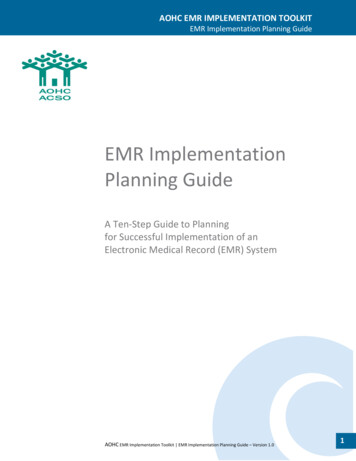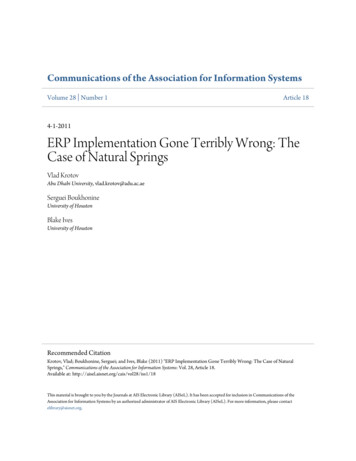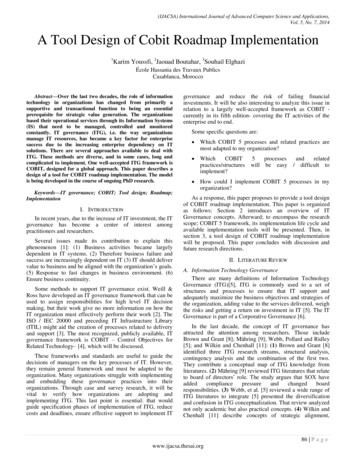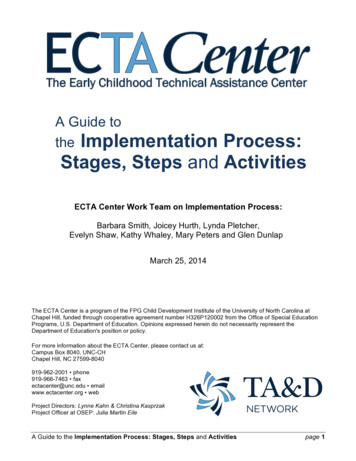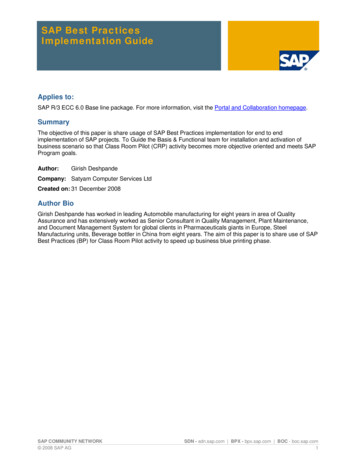
Transcription
Part VProgram Design andImplementationChapter 12Weight-managementProgrammingChapter 13ExerciseProgrammingChapter 14NutritionalProgrammingChapter 15LifestyleModification andBehavior ChangeChapter 16Adherence toPhysical Activity andWeight-loss Behaviors
Fabio ComanaFabio Comana, M.A., M.S.,is an exercise physiologist, researchscientist, and spokesperson for the American Council on Exercise.He also currently teaches courses in exercise science and nutritionat the University of California, San Diego and San Diego StateUniversity. Comana regularly presents and writes on many topicsrelated to exercise, fitness, and nutrition, and has authored orco-authored more than three dozen articles and chapters in variouspublications. He has master’s degrees in exercise physiologyand nutrition, and currently holds certifications from ACE, theAmerican College of Sports Medicine (ACSM), the National Strengthand Conditioning Association (NSCA), and the InternationalSociety of Sports Nutrition (ISSN).
Chapter 12Weight-managementProgrammingIn 2006, 72 million American dieters spent 55 billion in theweight-loss market, and forecasts estimate that amount to reachnearly 69 billion in 2010 (Marketdata Enterprises, Inc., 2007).According to the Centers for Disease Control and Prevention (CDC),there has been a rising trend of Americans considered overweightand obese: from 65.7% and 30.6% in 2001–2002 to 66.3% and32.2% in 2003–2004, 68% and 33.8% in 2005–2006, and 68.3% and33.9% in 2007–2008, respectively (Table 12-1).An effective weight-management program involves amultidisciplinary team approach that includes a physician,registered dietitian, exercise physiologist, and behavioraltherapist. Through this team approach, the three critical areas—behavior and lifestyle modification, nutrition, and physicalactivity—can be coordinated. While this approach is ideal, the costof employing a team of healthcare experts, combined with the lackof third-party reimbursement, creates potential barriers. Hence,IN THIS CHAPTER:Introduction toEffective Weight ManagementComponents of an Effective Weightmanagement ProgramPrevalence of ObesityPopulation StatisticsHealth ObjectivesSafe and Effective Weight LossUnderstanding Behavioral ChangeTranstheoretical Model of Change(Stages of Behavioral Change)Stages of ChangeProcesses of ChangeDecisional BalanceSelf-efficacyTracking Progress andKeeping RecordsParticipation and Activity LogsEmotional Association With Programmingoverweight or obese clients may instead opt to seek the services ofcompetent allied health professionals who are experienced in allthree disciplines and have an established referral network in place.The success of a Lifestyle & Weight Management Coach (LWMC)necessitates proven competencies in these areas and the ability toaddress the individualized needs of clients. The science behind eacharea is discussed earlier in this book, while the subsequent chaptersfocus on programming guidelines and strategies.Strategies for Overcoming ObstaclesBarriers to ParticipationRelapse PreventionSummary
Chapter 12Weight-management ProgrammingIntroduction to EffectiveWeight ManagementComponents of an Effective Weightmanagement ProgramLWMCs can expect to encounter obstacles, either identified or reported by theirclients, during the early stage of their relationship. During the interview and information-gathering stage, LWMCs may identifyinternal and external barriers. Internalbarriers could be anxieties, ambivalence,or defensive avoidance, such as rationalizing a decision to delay starting a program.External barriers could be the inconvenienceof the program, lack of time, or lack of support (Griffin, 2006).While LWMCs have the best intentionsfor their clients, they must act ethicallyand responsibly to determine what is appropriate, given the client’s current stageof behavioral change. LWMCs must neverassume that a meeting with a client meansthat he or she has entered the preparation or action stage of behavioral change,and is therefore ready to move forward.LWMCs must be skilled in identifying a client’s current stage of change and have theability to implement or recommend theappropriate strategies. This is a critical firststep toward facilitating a more permanentlifestyle change. Time and money investedin a nutritional or activity/exercise programmay be wasted if the client’s underlyingpsyche is not addressed first. The subsequent chapters address individual programming components of lifestyle and behavioralmodification, exercise, and nutrition.In general, the design of effectiveweight-management programs for clientsrequires that LWMCs gain a working knowledge of the following skill sets.Lifestyle and behavior modification: R eadiness to change behavior and identification of current stage of change P rocesses of change (cognitive and/or behavioral) and the shifting of a cli264L if estyle & W eigh t Man agem en t Coach Manualent’s decisional balance toward change(Prochaska & Marcus, 1994) Self-esteem, self-efficacy, and selfefficacy-building strategies Acknowledgement of, and reframing of,current attitudes, perceptions, apprehensions, and belief systems Value of cognitive techniques, such asgoal-setting Rapport building and maintenance Effective verbal and nonverbal communication, and good listening skills Different personality styles (e.g.,technical, sociable, or assertive) andappropriate communication styles(Griffin, 2006) Support systems Internal and external barriers andobstacle management Appropriate cognitive, motor-skill, andaffective learning techniques Motivational strategies, includingreinforcements, antecedents, rewards(extrinsic to intrinsic), personal contracts, stimulus control, and self-talkExercise programming: Exercise science Health-risk assessments and riskstratification Referrals to appropriate professionals,confidentiality, and SOAP note format Exercise and testing contraindications Physiological assessments and termination criteria Limitations of assessments and theinterpretation of criterion-referenced ornorm-referenced data Program design and implementation Environmental effects Reevaluation and modification/progressionNutritional programming: Nutrition (macronutrient and micronutrient function) and digestion Nutritional assessments Caloric balance and weight-management-program designAmerican Council On Exercise
Weight-management Programming Dietary guidelines, labels, and portionssizes Weight-loss diets and supplements Dietary needs for special populations,women, and vegetariansPrevalence of ObesityPopulation StatisticsThe National Health and NutritionExamination Survey (NHANES), which isconducted every 10 years by the NationalCenter for Health Statistics (NCHS) and theCDC, assesses the health and nutritionalstatus of adults and children in the UnitedStates. It is arguably the largest and longest-running longitudinal health survey ofthe U.S. population and provides valuableinformation on important health indicators. The prevalence of overweight andobesity has been tracked since 1971, anda rising trend is evident within the U.S.population (Table 12-1). In 2008, an estimated 154 million adults were overweightor obese; among women 20 years and older,more than 97 million were overweight, andmore than 49 million were obese.According to the CDC, the averagemale weighed 166.3 pounds (75.5 kg)in 1960–1962, while the average femaleweighed 140.2 pounds (63.7 kg). By contrast,in 1999–2002, the average male weighed191.0 pounds (86.7 kg), while the averagefemale weighed 164.3 pounds (74.6 kg).Chapter 12The increased incidence of obesity is attributed to decreasing levels of activity andincreasing access to, and consumption of,food. Physical-activity statistics from theDepartment of Health and Human Servicesand the Centers for Disease Control andPrevention in 2007 indicated that only 48.8%of U.S. adults were achieving the recommended physical-activity levels consistentwith the U.S. Surgeon General’s report; 37.7%were insufficiently active (defined as morethan 10 minutes total per week of moderateor vigorous-intensity lifestyle activities, butless than the recommended level of activity);13.5% of adults were inactive (defined as lessthan 10 minutes total per week of moderate- or vigorous-intensity lifestyle activities).Likewise, the average consumption of calories in adults increased by 12%, or 300 kcal,between 1985 and 2000.Being overweight or obese significantlyincreases the risk of developing serious disease and health conditions, including thefollowing: Hypertension Dyslipidemia Type 2 diabetes Coronary heart disease Stroke Gallbladder disease Osteoarthritis Sleep apnea and respiratory problems Some cancers (endometrial, breast,and colon)Table 12-1Age-adjusted Prevalence of Overweight and Obesity Among U.S Adults, Ages 20–74NHANES II(1976–1980)(n 11,207)NHANES III(1988–1994)(n 6,679)NHANES(1999–2000)(n 4,117)NHANES(2001–2002)(n 4,413)NHANES(2003–2004)(n 4,431)NHANES(2005–2006)(n 4,356)NHANES(2007–2008)(n 5,555)Overweight or Obese(BMI 25.0)47.0%56.0%64.5%65.7%66.3%68.0%68.3%Obese (BMI 30.0)15.0%22.9%30.5%30.6%32.2%33.8%33.9%* Age-adjusted by the direct method to the year 2000 U.S. Bureau of the Census estimates using the age groups 20–39, 40–59,and 60 years and over.Source: National Center for Health Statistics, Centers for Disease Control and PreventionAmerican Council On ExerciseLifest yle & Weight Management Coach Manual265
Chapter 12Weight-management ProgrammingThe Centers for Disease Control andPrevention had previously reported thatobesity is responsible for more than 356,000deaths a year, a number that has increasedby 33% over the past decade and may soonovertake tobacco as the leading preventable cause of death among Americans. Morerecently, a study based on a nationally representative sample of U.S. adults estimatedthat approximately 112,000 deaths are associated with obesity each year in the UnitedStates (Mokdad et al., 2004; 2005). There aretwo main reasons for the difference in theestimated number of obesity deaths—newerdata and different methods of analyzing thedata. Because obesity has many differenteffects on numerous diseases, doctors havedifficulty reliably identifying obesity-relateddeaths based on death certificates. Scientistsare now using more complex modeling techniques to estimate deaths related to obesity.Regardless, obesity shortens the averagelifespan of an adult by four to nine months,and in a child, the lifespan may be cut bytwo to five years, given the current childhoodobesity rates.Obesity-attributable medical expenditureshave been estimated to be 117 billion inthe U.S. (Finkelstein, Fiebelkorn, & Wang,2003). In 2002, the cost difference betweentreating a normal-weight person and anobese individual was 1,244, up from 272in 1987. In general, the annual medical costsfor overweight and obese individuals (underthe age of 65 years) is 14.5% and 36–37.4%higher compared to normal-weight individuals, respectively (Segel, 2006). Weight losscan reduce lifetime medical costs by 2,200to 5,300 per person.In the corporate world, the impact can besignificant. The hospital inpatient utilizationrate for workers with unhealthy weights was143% higher than for normal-weight workers.In March of 2005, the annual premium for anemployee averaged 6,281.Since 2000, employment-based healthinsurance premiums have risen 73% (TheHenry J. Kaiser Family Foundation, 2005).Meanwhile, the average employee contribu266L if estyle & W eigh t Man agem en t Coach Manualtion to health insurance grew more than143%, with employees paying 1,094 morein annual premiums for family coverage(Smith et al., 2006).Health ObjectivesGiven the rising obesity and inactivitylevels and correlating higher healthcare costs,being proactive in weight-management iscritical. These issues are also being addressedat a federal level, which could affect corporations and consumers working with LWMCs.The mission of the Center for NutritionPolicy and Promotion, an entity within theU.S. Department of Agriculture (USDA), isto improve the nutrition and well-being ofAmericans. In support of these objectives,the center offers several core resources,including the following: Dietary Guidelines for Americans My Pyramid Food Guidance System Healthy Eating Index U.S. Food Plans Nutrient Content of the U.S. Food Supply Expenditures on Children by FamiliesThe USDA Dietary Guidelines are published every five years by the USDA (seepage 160). The guidelines provide educational material on good dietary habits topromote healthy living and reduce the riskfor developing major chronic diseases for allAmericans (from age two to aging adults).In 1979, the U.S. Surgeon General established national health objectives that servedas the basis for the development of state andcommunity health plans (U.S. Departmentof Health and Human Services, 2000). Theobjectives were developed through a broadconsultation process, derived from currentscientific knowledge, and designed to measure programs over time. Healthy People, thestatement of these national health objectives,is designed to identify the most significantpreventable threats to health, and to establish a national consensus of how to reducethem. The current version, Healthy People2010, contains 467 objectives in 28 focusareas (U.S. Department of Health and HumanServices, 2000). Under focus area number 19,American Council On Exercise
Weight-management Programmingentitled “Overweight and Obesity,” specificobjectives include the following: Objective 19-1: Increase the proportionof healthy-weight adults to at least 60% Objective 19-2: Reduce the proportion ofobese adults to less than 15%The National Institutes of Health (NIH) in2005 developed a strategic plan for obesityresearch, earmarking a budget of 440.3 million. The NIH recognizes the multifacetedvariables that affect obesity. Its plan to fightobesity is organized into four major themesrelated to obesity prevention and treatment: Lifestyle modification Pharmacologic, surgical, or other medicalapproaches The link between obesity and associatedhealth conditions Crosscutting research topics, includinghealth disparities and technologyThe Food and Drug Administration’s(FDA) Obesity Working Group releasedits final report in 2004 (U.S. FDA, 2004).The group’s long- and short-term proposals are based on the scientific knowledgethat weight control is primarily a functionof caloric balance. Consequently, the FDAfocuses on calorie counting in its obesity campaign. The FDA’s ongoing actionsinclude the following: Labeling: Enhancing food labels todisplay the calorie count more prominently, and implementing more meaningful serving sizes Enforcement agencies: Collaboratingwith the Federal Trade Commission(FTC) to increase enforcement againstweight-loss products that have false ormisleading claims, and products thatdeclare inaccurate serving sizes Educational partnerships: Workingcooperatively with other governmentagencies, nonprofits, industry, andacademia to educate Americans on thedangers of obesity and the importanceof leading healthier lives through better nutrition Restaurants: Encouraging the restaurant industry to launch a nationwide,American Council On ExerciseChapter 12voluntary, and point-of-sale nutritioninformation campaign for consumers Therapeutics: Revising FDA guidancefor developing obesity drugs andaddressing challenges and gaps inknowledge about existing drug therapies for treating obesity Research: Supporting others and collaborating (with others, such as theNIH) on obesity-related researchSafe and EffectiveWeight LossLifestyle changes, including modifications of food intake and physical activity to establish a daily negative caloricbalance, remain the hallmarks of effectiveprogramming. It can be difficult to accuratelyestimate weight-loss rates for clients giventhe numerous factors influencing weightloss. Additionally, using weight-loss rateis not recommended for long-term weightmanagement, because of the potential leanbody mass gain that accompanies overloadwith resistance training. Instead, it is best tofocus the client’s attention on the perceivedbenefits of accomplishing various programrelated goals, such as changes in body shapeand image, and self-efficacy.Modest and realistic expectations includeachieving an initial 5 to 10% reduction inbody weight, as this range is consistent withimproved overall health benefits, increasedself-efficacy, and improved adherence[American College of Sports Medicine (ACSM),2010]. Always follow a prudent plan with aweight-loss goal that is consistent with themost current dietary guidelines, unless clients are medically supervised by a licensedphysician or registered dietitian. The 2005USDA Dietary Guidelines and the 2010 ACSMguidelines recommend a weekly weight lossof 0.5 to 1.0 kg (1.1 to 2.2 pounds) per week,which necessitates a negative caloric balanceof 3,850 to 7,700 kcal weekly, or 550 to 1,100kcal daily. A more conservative approach of0.5 to 1.0 pounds (0.23 to 0.45 kg) per week,Lifest yle & Weight Management Coach Manual267
Weight-management ProgrammingChapter 12necessitating a negative caloric balance of1,750 to 3,500 kcal weekly, or 250 to 500 kcaldaily, may be more suitable for some clients.Ultimately, the weight-loss goal must be safe,satisfy the needs and desires of the client,and include the following considerations: Age Target weight (or amount ofweight to be lost) Current physical-activity level Medical concerns History of dieting Emotional and psychological stateIndividuals do not need to lose weight iftheir weight is within the healthy range represented in Table 12-2, if they have gainedless than 10 pounds since reaching theiradult height, or are otherwise healthy (USDA,Table 12-2Healthy Weight Ranges for Men and WomenHeightWeight (pounds)Weight (kg)4'10" (1.47 m)91–11941.4–54.14'11" (1.50 m)94–12442.7–56.45'0" (1.52 m)97–12844.1–58.25'1" (1.55 m)101–13245.9–60.05'2" (1.57 m)104–13747.2–62.25'3" (1.60 m)107–14148.6–64.15'4" (1.62 m)111–14650.5–66.45'5" (1.65 m)114–15051.8–68.25'6" (1.67 m)118–15553.6–70.55'7" (1.70m)121–16055.0–72.75'8" (1.73 m)125–16456.8–74.55'9" (1.75 m)129–16958.6–76.85'10" (1.77 m)132–17460.0–79.15'11" (1.80 m)136–17961.8–81.46'0" (1.83 m)140–18463.6–83.66'1" (1.85 m)144–18965.5–85.96'2" (1.87 m)148–19567.3–88.66'3" (1.90 m)152–20069.1–90.16'4" (1.93 m)156–20570.9–93.26'5" (1.95 m)160–21172.7–95.96'6" (1.98 m )164–21674.5–98.2Source: United States Department of Agriculture (2005). USDA DietaryGuidelines for Americans. www.health.gov/dietaryguidelines.268L if estyle & W eigh t Man agem en t Coach Manual2005). Weight losses of only 5 to 10% maygreatly diminish any health concerns associated with being overweight, but even smallerlosses can make a difference. Weights abovethe ranges shown in Table 12-2 are consideredless healthy for most people. The greater themargin of difference between actual bodyweight and the healthy weight range forheight, the higher the risk of weight-relatedhealth disorders.A more useful estimate of quantifying ahealthy weight in relation to height can beobtained by calculating a height-normalizedweight index. The body mass index (BMI)is the most commonly used indicator (Table12–3). While the BMI has limited applicationsfor athletes, seniors, and children, researchpoints to a strong relationship between BMIand mortality rates. In a research study following 1 million adults for 14 years, thelowest BMI-mortality rates were BMI scoresbetween 23.5 and 24.9 for men and 23.0 and23.4 for women.UnderstandingBehavioral ChangePeople make choices and decisions basedon how they feel and think (Figure12-1). Everyone’s belief system is basedon past and present experiences. These beliefsystems drive people’s thought processes andfeelings, and the decisions and choices theymake. To influence desired behaviors, LWMCsmust work with clients to help them thinkabout ways to achieve desirable behaviors andtalk to them about their feelings about thosedesired behaviors. LWMCs may successfullyalter unfounded belief systems to influencedecisions and choices. Additionally, theseexperiences should be engaging, positive, andmemorable, and build self-efficacy to empower clients to want to stop unhealthy behaviors, while also enhancing their confidence intheir abilities to initiate change.Using a weight-management example toillustrate this point, imagine a client withan estimated caloric intake of 2,000 kcal,American Council On Exercise
Weight-management ProgrammingChapter 12Table 12-3Body Mass IndexHeight 138142147151155160165169174179184189242526Weight (pounds)115 119 124119 124 128123 128 133127 132 137131 136 142135 141 146140 145 151144 150 156148 155 161153 159 166158 164 171162 169 176167 174 181172 179 186177 184 191182 189 197187 194 202192 200 208197 205 1319328Note: Find your client’s height in the far left column and move across the row to the weight that is closest to the client’s weight. His or her body mass index will be at the top of that column.}Subconsciouswho would like to lose 1 pound (0.45 kg) perweek. Long-term weight-loss success typically involves modest caloric reductions of 10to 15% initially, although some studies dodemonstrate long-term success with initialcaloric reductions of 20 to 25%. Using a modest reduction of 300 kcal of intake leaves abalance of 200 kcal that must be expended viaphysical activity and exercise. Most overweightAmerican Council On ExerciseFigure 12-1}Influences ondecisions andchoicesConsciousclients tend to be deconditioned and are better suited to walking or performing walk-jogintervals for exercise that burns between 5 and9 kcal per minute (for a 165-pound or 75-kgindividual). To expend 200 kcal, the individualneeds to participate in 23 minutes of jogging or 40 minutes of walking. Consideringthat only 46% of the U.S adult populationmeets minimum recommendations of theLifest yle & Weight Management Coach Manual269
Chapter 12Weight-management ProgrammingU.S Surgeon General, 38% participate in 10to 30 minutes of physical activity, and 16%participate in less than 10 minutes of physical activity daily, the likelihood of success inexpending 200 kcal is low. More importantly,the individual may potentially have a negativeand unenjoyable experience that might proveto be disengaging. Remember that the initialfew weeks of a program have a high risk ofdropout. A viable option may be to increasedaily physical activity levels to expend 75 to100 kcal, leaving the balance to structuredexercise, but keep in mind that too manylifestyle changes may negatively impact longterm adherence. Consider the following strategy to enhance the overall experience, engagethe individual, and promote self-efficacy: F ocus the initial two to four weekson building self-efficacy and programcompliance and creating an enjoyableexperience. De-emphasize numbers temporarily untilattitudes toward regular exercise andactivity appear positive and the desiredbehaviors occur frequently with minimalresistance.Transtheoretical Modelof Change (Stages ofBehavioral Change)This model was developed as a frameworkto describe the different stages of acquiring and maintaining healthy behavior.It provides a premise to understand lifestylemodification based upon readiness for change,making the assumption that people progressthrough stages of behavioral change at varying rates (Prochaska & Marcus, 1994). Toadopt or engage in new behaviors, individuals must first move in an orderly progressionthrough a number of stages. The model alsotakes into account that lapses are inevitableand part of the process of working towardlifelong change. Hence, it is possible for anindividual to move in either direction alongthis continuum. The four components of this270L if estyle & W eigh t Man agem en t Coach Manualmodel, which are constructs hypothesized toinfluence behavior, are as follows: Stages of change Processes of change Decisional balance Self-efficacyStages of ChangeThere are five stages of change describedin the transtheoretical model (Table 12-4 andFigure 12-2):Precontemplation: The individual has no plans or thoughtsto improve or change behavior withinthe next six months. The individual is neither engaged inchange, nor contemplating it. The individual may have lapsed or isin denial at this level. He or she isresigned to the unhealthy behaviorbecause of previous failed efforts and nolonger believes that he or she can controlchange.Contemplation: The individual is somewhat ambivalenttoward changing behavior and weighsthe costs and benefits of making the lifestyle modification. The individual is not engaged, but iscontemplating improving or changingbehavior within the next six months(“thinking about it”). Low self-efficacy levels increase the resistance to changing behavior.Preparation: The individual has taken some stepstoward healthier behavior and intends tocommit within the next 30 days, or hasalready begun to make some changes,but demonstrates inconsistent behavior (irregular activity patterns). Thereis, however, greater determination toachieve change. The individual is mentally and physically preparing and may ask questions,seek information, or make purchases(of equipment, etc.) as an incentiveto commit.American Council On Exercise
Weight-management ProgrammingChapter 12Table 12-4The Stages of Behavior ChangeStageTraitsPrecontemplation Unaware or under-aware ofthe problem, or believe thatit cannot be solved (e.g.,latent pain)ContemplationAware of the problem andweighing the benefitsversus risks of changeGoalsStrategiesIncrease awareness of theValidate lack of readiness to change and clarify that thisrisks of inactivity, and of the decision is theirsbenefits of activityEncourage reevaluation of current behavior and self-exploration,Focus on addressingwhile not taking actionsomething relevant to them Explain and personalize the inherent risksHave them start thinkingabout changeUtilize general sources, including media, Internet, andbrochures to increase awarenessInform them of availableoptionsValidate lack of readiness to change and clarify that thisdecision is theirsProvide cues to action andHave little understanding of some basic structuredhow to go about changingdirectionEncourage evaluation of the pros and cons of making changeI dentify and promote new, positive outcome expectations andboost self-confidence Offer invitations to become more active (e.g., free trials)PreparationActionSeeking opportunitiesto participate in activity(combine intent andbehavior with activity)Structured, regularprogramming with frequentpositive feedback andreinforcements on theirprogressVerify that the individual has the underlying skills for behaviorchange and encourage small steps toward building self-efficacyDesire for opportunities tomaintain activitiesEstablish exercise as ahabit through motivationand adherence to thedesired behaviorBehavior-modification strategiesChanging beliefs andattitudesHigh risk for lapses orreturns to undesirablebehaviorMaintenanceEmpowered, but desirea means to maintainadherence Identify and assist with problem-solving obstacles Help the client identify social support and establish goalsFocus on restructuring cues and social support toward buildinglong-term changeIncrease awareness to inevitable lapses and bolster selfefficacy in coping with lapses Reiterate long-term benefits of adherence Require continual feedback on progressMaintain support systemsReevaluate strategies currently in effectMaintain interest and avoidboredom or burnoutPlan for contingencies with support systems, although this mayno longer be neededGood capability to dealwith lapsesR einforce the need for a transition from external to internalrewardsPlan for potential lapsesEncourage program varietyLapseEncounter lapses that theyare unable to overcomeReturn to actionIdentify reasons for lapseI dentify current stage of change to progress once again towardaction aintain existing systems and relationships and offerMappropriate supportAmerican Council On ExerciseLifest yle & Weight Management Coach Manual271
Chapter 12Weight-management ProgrammingFigure 12-2The stagesof behavioralchange***** When adopting healthy behaviors, termination represents thecomplete adoption of behavioral traits of a particular stageand readiness to move forward to the next stage.Action: The individual has shown improvedbehavior, and has been participating inregular activity for less than six months. The individual demonstrates the desireto change his or her beliefs and attitudes, and should be supported asmuch as possible. The individual is still considered to be ata high risk for relapse.Maintenance: Practices have been sustained for morethan six months. The person demonstrates adherence and higher levels ofself-efficacy. The individual has successfully developed strategies to cope with lapses. Discouragement with occasional slips orlapses may hamper maintenance withinthis phase and result in the individualreversing into unhealthy behaviors. Atypical pattern involves cycling throughthe stages of change several times before272L if estyle & W eigh t Man agem en t Coach Manualthe change becomes truly established asa lifelong
AMERICAN COUNCIL ON ExERCISE Lifestyle & Weight Management Coach Manual 265 Dietary guidelines, labels, and portions sizes Weight-loss diets and supplements Dietary needs for special populations, women, and vegetarians Prevalence of Obesity Population Statistics The National Health
